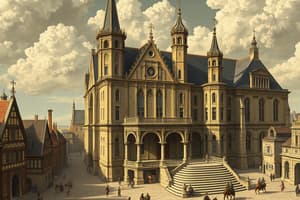Podcast
Questions and Answers
Какие научные дисциплины развивались благодаря монашеству в Средние века?
Какие научные дисциплины развивались благодаря монашеству в Средние века?
- Философия, теология, естественные науки (correct)
- Экономика, политология, социология
- Биология, география, антропология
- Математика, физика, химия
Какие сооружения были символами влияния и власти Церкви в Средние века?
Какие сооружения были символами влияния и власти Церкви в Средние века?
- Готические соборы (correct)
- Монастыри и церкви
- Замки и крепости
- Университеты и библиотеки
Как монастыри влияли на ход политики и дипломатии в Средние века?
Как монастыри влияли на ход политики и дипломатии в Средние века?
- Через участие в крестовых походах
- Через владение земельными ресурсами и поколение дохода (correct)
- Через проповеди и миссионерскую деятельность
- Через организацию торжеств и церемоний
Какие области знаний были основными для образования будущих священнослужителей?
Какие области знаний были основными для образования будущих священнослужителей?
Как монашество влило на европейскую историю?
Как монашество влило на европейскую историю?
Какова былаmain цель монашеской жизни в средние века?
Какова былаmain цель монашеской жизни в средние века?
Какие религиозные институты возникли в средние века и имели уникальные практики и идеалы?
Какие религиозные институты возникли в средние века и имели уникальные практики и идеалы?
Какую роль играли монастыри в области образования в средние века?
Какую роль играли монастыри в области образования в средние века?
Что было характерной чертой монашеской жизни в средние века?
Что было характерной чертой монашеской жизни в средние века?
Как монастыри влияли на религиозную жизнь в средние века?
Как монастыри влияли на религиозную жизнь в средние века?
Flashcards are hidden until you start studying
Study Notes
Monasticism in the Middle Ages
Monasticism, a religious practice involving the establishment of communities of monks or nuns who live under a common rule, played a significant role in the Middle Ages. During this period, monastic communities were established throughout Europe, and their influence extended beyond religious life to education and intellectual pursuits.
The Role of Monasticism in Religious Life
Monasticism was an integral part of the medieval religious landscape. Monks and nuns lived in communities, following a common set of rules and practices designed to help them draw closer to God. The monastic life was characterized by prayer, study, and manual labor, all aimed at fostering a deeper spiritual connection.
Monastic orders, such as the Benedictines and Franciscans, emerged during this time, each with its unique set of practices and ideals. These orders attracted many individuals seeking a more focused spiritual life, and their influence on the religious landscape was significant.
Monasticism and Education
Monasteries served as centers of learning during the Middle Ages. They were responsible for preserving and transmitting knowledge when the Roman Empire's educational institutions were in decline. Monks and nuns played a crucial role in copying and transmitting texts, preserving the works of classical authors and Christian theologians.
Monasteries also became the centers of education, with monks and nuns teaching young boys and girls in the monastic schools. These schools focused on the transmission of knowledge, particularly in the areas of grammar, rhetoric, and logic, which were essential for the education of future clergy.
Monasticism and Intellectual Pursuits
Monasticism influenced intellectual life during the Middle Ages in several ways. Monks and nuns were encouraged to study and engage with various disciplines, including philosophy, theology, and the natural sciences. Their intellectual pursuits led to significant advancements in these fields.
Moreover, monastic communities were responsible for the development of many of the great cathedrals that still stand today. These structures, often built in the distinctive Gothic architectural style, were symbols of the Church's influence and power during the Middle Ages.
The Economic Impact of Monasticism
Monasteries were not only religious and educational institutions but also economic entities. They owned vast tracts of land, which they used to produce goods and generate income. This wealth, in turn, allowed the Church to wield significant political power, as it could use its resources to influence the course of politics and diplomacy.
Conclusion
Monasticism played a crucial role in the religious, educational, intellectual, and economic life of the Middle Ages. Its influence extended beyond the confines of monasteries, shaping the course of European history in profound ways. Despite their best efforts to regulate their lives and eliminate distractions, monks still struggled with the demands of their bodies and the world around them. Nonetheless, their spiritual pursuits and intellectual achievements left a lasting impact on the European landscape, shaping the course of history for centuries to come.
Studying That Suits You
Use AI to generate personalized quizzes and flashcards to suit your learning preferences.




